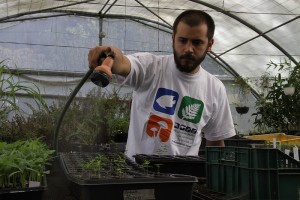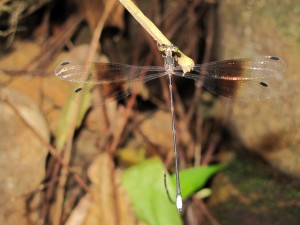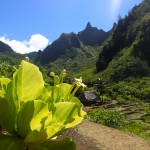We recently received this photograph of Brighamia insignis from Seana Walsh, a June 2013 grant recipient who is working on the plant’s breeding systems and pollination ecology. Though there are only two Brighamia insignis remaining in the wild, we think the photograph symbolizes our hope for species conservation. We are inspired by the enthusiasm, energy, and dedication of our grant recipients. We wish everyone a successful new year. Keep up the good work.
Month: December 2013
Happy New Year from the Fund
Georgian camera trap survey finds all but Persian leopard
To find evidence of the Persian leopard (Panthera pardus saxicolor), Bejan Lortkipanidze and his team set 30 camera traps in the northern part of the Greater Caucasus Mountain Range – a very remote area of Georgia near its boarder with Russia.
Although most cameras have been retrieved, five were stolen (presumably by poachers concerned about the evidence) and a few others were left in an area where leopard sightings were reported by villagers. Despite these set backs, the cameras recorded an ample population of leopard prey. Read more…
For the 3rd time in 2013, the Fund distributes more than $500k to support the world’s most endangered species
For the 3rd time in 2013, the Fund distributes more than $500k in support of the world’s most endangered species bringing its annual contribution in 2013 to $1,605,091.
As a result of its recent review of grant applications, the Mohamed bin Zayed Species Conservation Fund is distributing $519,666 to 65 conservation projects located in 45 countries across the world. This is the third distribution of Funds in 2013. The total distribution to projects in 2013 amounted to $1,605,091.
Since its inception in 2008 the Fund has distributed $10,328,429 to more than 1,000 species conservation projects worldwide.
Small Wild Cat Conservation Alliance contributes $11k to complement 5 recently approved projects
The Fund supported five small wild cat conservation projects in its most recent round of grant giving. The Small Wild Cat Conservation Alliance (SWCCA) generously contributed $11,000 to these same projects. Each of the five small wild cat projects will now receive full funding. Read more…
Recent Survey estimates only 23 breeding pairs of Norfolk island parakeets remain
Off the eastern coast of Australia, the Norfolk Island parakeet population nearly collapsed in the 1980s, but rebounded after a focused conservation effort. However, there are concerns that on-going rat and cat predation may again be causing a serious decline in numbers. The Fund helped researchers investigate the situation.
Read more…
Efforts to reintroduce the Socorro Dove are underway
 Plants endemic to the remote Pacific island of Socorro (Mexico) are being grown ex-situ by Dr. Juan Martinez-Gómez in preparation for the reintroduction of the Socorro dove. The plants, upon which the Socorro dove depend, have been devastated by sheep that were introduced 150 years ago.
Plants endemic to the remote Pacific island of Socorro (Mexico) are being grown ex-situ by Dr. Juan Martinez-Gómez in preparation for the reintroduction of the Socorro dove. The plants, upon which the Socorro dove depend, have been devastated by sheep that were introduced 150 years ago.
The Socorro dove project involves many conservation partners addressing the many different conservation challenges facing this reintroduction. The Mexican Navy, for example, is providing transportation and helping to retrofit abandoned buildings by turning them into greenhouses and captive breeding facilities.
You can read more about the project and view a photo essay in our case study pages.
Fund Video: Effects of water temp and lineage on coral survivorship
In a video produced by the Fund, the NYU Abu Dhabi coral research lab explains a research project investigating the effects of water temperature and coral parentage on survivorship.
[su_youtube url=”http://youtu.be/hFNWKYhQcyI”]
Fund Video: Staghorn coral study in Arabian Gulf
The Fund provided NYU Abu Dhabi with a small grant to assist their study of Staghorn coral in the Arabian Gulf. Once covering vast areas along the UAE shores of the Arabian Gulf, the staghorn coral is quickly disappearing. Threats such as coastal development, raising sea temperatures, and dredging have significantly affected these historically resilient coral.
The Fund produced a short documentary about the project. You can watch it here….
[su_youtube url=”http://youtu.be/RHOl95s1Dz4″]
Second site discovered for Tanzania’s Critically Endnagered Amani flatwing dragonfly

The recent discovery of a second site where the Amani flatwing dragonfly lives may help increase its chances of survival.
The Fund gave Dr. Viola Clausnitzer $8,000 to help conserve the Amani flatwing dragonfly (Amanipodagrion gilliesi) in Tanzania. The grant helped fund a community workshop and train local field guides to identify and conserve this Critically Endangered species. Dr Clausnitzer recently reported to the Fund that “The field guides, who do the monitoring, have reported a 2nd site, where they found the Amani Flatwing. The future of this species is in much safer hands than before, just because the local people are aware of the rarity within their forest.” Read more…
Advisory Board reviews applications and submits recommendations to Fund
The Advisory Board met this week in Abu Dhabi to review nearly 500 grant applications. These grant applications were submitted between 1 July and 31 October 2013. In total nearly $10m was requested from all these applications.




